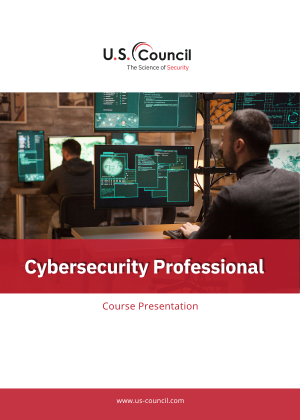 Certified Cybersecurity Professional
Certified Cybersecurity Professional
 Certified Cybersecurity Professional
Certified Cybersecurity Professional
 Certified Cybersecurity Professional
Certified Cybersecurity Professional
Course Overview
The cybersecurity professional certificate course is geared towards creating the absolute cybersecurity expert, equally at ease in providing security for futuristic networks and legacy systems.
The cybersecurity professional course provides comprehensive training in all aspects of cyber defense methodologies. This course covers the proactive defense mechanisms required of a cybersecurity professional including ethical hacking, firewalls, IPS, vulnerability assessment and cryptography. Vital cybersecurity reactive techniques are also discussed including SIEM, mobile and digital forensics, log analysis and patch management. This course consists of three modules viz
- Security Risk Assessment (Ethical Hacking)
- Proactive Defense and Countermeasures
- Incident Response and Management
A thorough understanding of the underlying principles of networking and operating systems is a prerequisite to pursuing this advanced course. The student is expected to be knowledgeable in IP networks, TCP / IP stack, protocols like http, https, ICMP, ARP, services like DNS, DHCP, LDAP, telnet, ssh as well as routing protocols like RIP, EIGRP, BGP, etc. Expertise in Linux and Windows servers and related technologies is a must.
Key Topics:
- Security Risk Assessment
- Dos and DDos Attacks
- Attack Mitigation Techniques
- Firewalls, IDS, IPS
- Cryptography
- Incident Response and Management
- Log Analysis
- Forensics
Course Curriculum
Security Risk Assessment (Ethical Hacking)
Module 1:Introduction to Cybersecurity
- What is Hacking
- What is Ethical Hacking
- What is Penetration Testing
- What is Vulnerability Auditing
Module 2:Footprinting
- What is FootPrinting
- Footprinting Techniques
- Footprinting Website & Tools
Module 3:Scanning
- What is Network scanning
- Types of Scanners
- Vulnerability Scanner Tools
Module 4:Proxy
- What is a proxy server
- Types of proxies
- What is a Darkweb
- Why hackers prefer to use Darkweb
Module 5:Hacking Web Servers & Web Applications
- What is a web server
- Types of web attacks
Module 6:Session Hijacking
- What is session hijacking
- Session hijacking Techniques
- Session hijacking Tools
Module 7:Denial of Service
- What is a DoS and DDoS attack
- DoS attack techniques
- DoS attack Tools
Module 8:System Hacking
- What is System Hacking
- What is Password Cracking
- Password Cracking techniques
- Password Cracking Website & Tools
Module 9:Sniffers
- What is a sniffer
- Sniffing Techniques
- Sniffing Tools
Module 10:Phishing
- What is Phishing
- Phishing Techniques
- Phishing Tools
Module 11:Malware
- What is malware
- Types of malware
- Malware creation Tools
- USB password stealers
Module 12:Wireless Hacking
- Types of wireless networks
- Wireless Hacking Techniques
- Wireless Hacking Tools
Module 13:Kali Linux
- What is Kali Linux
- Kali Linux Tools
Proactive Defence and Countermeasures
Module 14:Introduction to Security
- What is security?
- Layer 1 Security
- Layer 2 Security
- Layer 3 security
Module 15:Firewalls
- What is a Firewall?
- Types of firewalls
- Designing Security with Firewalls
- NAT
- Security Policy
- Logs Management
- Application Security
- Content / Web Security
- Authentication
Module 16:Virtual Private Networks
- What is VPNs
- Type of VPNs
- GRE
- IPSEC
- SSL
Module 17: Intrusion Prevention Systems
- What is an Intrusion Detection System?
- What is an Intrusion Prevention System?
Module 18:High Availability Virtual / Cloud Devices Security Host Security
- OS Hardening
- Patch management
- Antivirus
- Endpoint Security
SIEM & Incident Response
Module 19:SIEM
- SIEM
- What is SIEM
- Incident Response
- What is Incident Response
Schedule
Update Soon

- Duration: 1 Month (52 Hours)
- Mode Of Training: Online
- Placement Assistance: Yes
- Certificate: Yes


